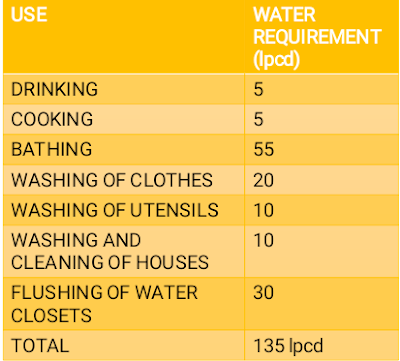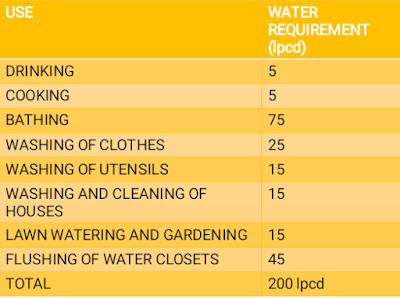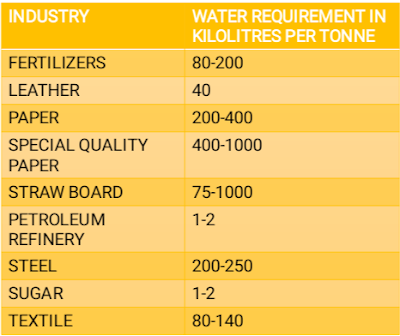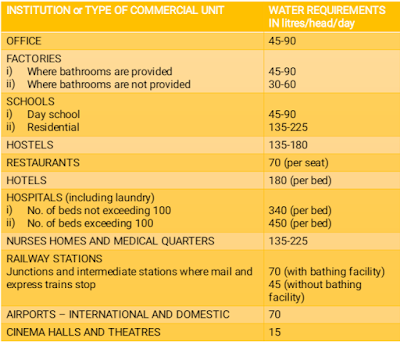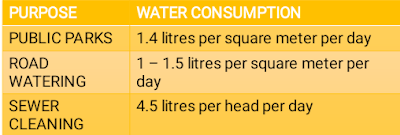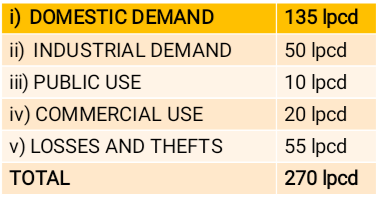WATER REQUIREMENTS (WATER DEMANDS)
Before designing a proper water supply project it is very important to determine the quantity of water required daily.
Determination of total water requirement of a community is of prime consideration for design of all the water supply units including the intakes, pumps, treatment plants, and pipelines of the distribution system.
The total consumption per day will be a product of total population and the consumption of water per person (per head) per day.
So determination of total water requirement involves determination of :
i) Water demand( per day)
ii) Population
i) Water demand :
The total quantity of water can be estimated by estimating the water required for different purposes.
The water requirement is generally expressed in terms of average number of litres of water per capita per day (lpcd) throughout the year.
The various types of water demands which a city /town may have can be divided in to following classes:
1. Domestic or residential
2. Industrial
3. Institutional and commercial
4. Fire demand
5. Demand for public uses
6. Water required to compensate losses in waste and thefts
1) DOMESTIC OR RESIDENTIAL WATER DEMAND :
There are number of activities in daily life where water is needed e.g. drinking, bathing, cooking, washing of utensils, clothes, cleaning of house, vehicles etc.
The water demand depends on population, living standard and habits of community, season of the year, climate of the place etc.
The environmental hygiene committee suggested certain rates based on population.
IS 1172-1983 on water supply and drainage and sanitation suggested minimum 135 liters of water per day for every person or capita (lpcd) for economically weaker section and LIG colonies and 200 lpcd for a town or a city with full flushing system.
As in India LIG and economically weaker section forms the majority of population and also full flushing system is not available in every house, generally in India, 135 lpcd is taken for design purpose is the bare minimum rate of consumption.
The IS code infact lays down a limit on domestic water consumption between 135-225 lpcd.
In developed countries like USA this figure may go as high as 340 lpcd. This is because more water is consumed in rich living in air conditioning, dish washing utensils, bathing in bath tubs etc.
Table gives minimum water demand for domestic purpose per capita per day (Ipcd) for Weaker sections and LIG colonies in small Indian towns and cities :
Table gives minimum domestic water consumption for Indian towns and cities with full flushing system:
The total domestic water consumption usually amounts to 50-60% of the total water consumption.
The total domestic water demand shall be equal to total design population multiplied by per capita domestic consumption.
2) INDUSTRIAL WATER DEMAND :
The industrial demand represent the water demand of industries, which are existing or are likely to be started in the future, in the city for which water supply is being planned.
This demand depends on the number and types of the industries.
There are different uses of water in industry.
It may be for process use, like chemical industries need water as a solvent.
Non process uses like cooling, washing of machine floors, working staff needs etc.
All the demands are added and a sum total is expressed in terms of a unit related with the product or material.
Some industries need huge quantities of water while some may need very little.
Example; A paper industry needs 200-400KL, per unit per ton of paper and petroleum refinery needs 1 to 2 KL per ton of crude refined.
For a city with moderate number of industries a provision of 20 to 25% of per capita consumption may be made for this purpose.
It may be generally taken as 50 litres/person/day which is sufficient only to meet the water demand of small scattered industries.
Separate provision is made for specific type of large industries.
Table gives Water Demands For Certain Important Industries :
3) INSTITUTIONAL AND COMMERCIAL WATER DEMAND :
The water requirement for different institute is different depending upon the type and function of the institute.
For example approximately 450 lit/day is required per bed in a hospital. Similarly water requirement for Hotels, Restaurants, Schools, Colleges are different.
On an average per capita demand of 20 lpcd is usually considered to be enough to meet institutional and commercial demand.
This demand can be as high as 50 Ipcd for highly commercialized cities.
Table gives Water for Institutional Needs :
4) DEMAND FOR PUBLIC USES :
This includes the quantity of water required for public utility purposes, such as watering of public parks, gardening, washing and sprinkling on roads, use in public fountains etc.
For the most of the water supply schemes in India, these needs are not considered essential and a nominal amount not exceeding 5% of the total consumption may be added to meet this demand.
Usually 10 lpcd is added for this demand while computing the total demand.
Table gives the water consumption for some of the public uses :
5) FIRE DEMAND :
The demand of water for extinguishing fire is very small in a year but the rate of consumption is large.
The water supply scheme should provide the necessary peak demand of water for fire fighting.
The water requirement for extinguishing fire depends on bulk, congestion and fire resistance of buildings.
Indirectly we can say that it mainly depends on population.
The minimum limit of fire demand is the amount and rate of supply that are required to extinguish the largest probable fire that may occur in a town.
The following empirical formulae may be used where Q is demand in litres per minute and P is the population in thousands.
The formulae mentioned above do not take into account the probability of fire occurrence, and its duration.
An approximate relationship
is used to take in to account the duration and frequency of fire occurance.
Where
Q = discharge in litres per minute,
t = duration of fire in minutes
T = frequency of fires in years.
The value of T will be different for urban and rural population. Minimum recommended values of t and T are 30 minutes and 1 year.
Fire hydrants 15 cm in diameter connected to street water supply mains are provided on all streets at maximum interval of 150m on crossing and bends, etc.
In case of any fire the trucks from the fire stations are sent to the site immediately and pumps are connected to the fire hydrants.
The water is pumped under sufficient pressure (0.1 to 0.2 N/mm) to reach several storey high and fire is extinguished.
In Indian conditions a provision of 1 litre per head per day will be sufficient for fire fighting.
6) WATER REQUIRED TO COMPENSATE LOSSES IN WASTE AND THEFT :
This includes the water lost in leakage due to bad plumbing or damaged meter, stolen water due to unauthorized water connections and other losses and wastes.
These losses should be taken in to account while estimating the total requirements.
These losses can be reduced by careful maintenance and universal metering.
Even in the best managed water works, this amount may, however, be as high as 154 of the total consumption
PER CAPITA DEMAND :
If the daily demand on average basis of a town or city is required to e calculated, we should find out the water required by a person considering all the above mentioned demand per day and for knowing the total average daily demand of the city the total population of the city is multiplied with this total demand.
If Q is the total quantity of water supplied to a town yearly then per capita demand of that city is
2) Population determination :
Determination of population is one of the most important factors in planning a water supply project, if the project has to serve the community for a certain design period.
Normally a design period of 20 to 40 years is selected.
The population at the end of the design period can be found out by using different methods of population forecasting.

